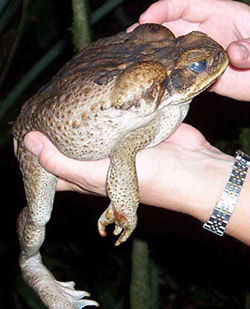 TO ANY AND ALL WHO HAVE PETS, SMALL OR LARGE!!
TO ANY AND ALL WHO HAVE PETS, SMALL OR LARGE!!I just found out about these toads that hurricane Fay brought here to Florida. They are called Bufo Toads. They will litterly EAT small animals! It is really scary! This is a report I found that I have copied and paisted...I hope this report was helpful. [-;
To the growing list of environmental problems exacerbated by Tropical Storm Fay, add dog-killing toads.
“Just like we’ve had an influx of (non-native Cuban) treefrogs since (Tropical Storm) Fay,” said Ken Gioeli, natural resources agent at the St. Lucie County Cooperative Extension Service, “stagnant fresh water is a prime location for cane toad tadpoles.”
Cane toads, also known as bufo toads, can secrete a milky substance from glands behind their ears that’s toxic enough to kill animals under 40 pounds and make larger animals incredibly sick. Dogs are particularly vulnerable because they often try to eat the large toads.
Even if a dog just sniffs a bufo toad, Gioeli said, “the stuff can get on his nose, and he might lick it, transferring it into his mouth.”
Greta Wester of Hobe Sound found that out the hard way when her toy poodle, Cherie, recently grabbed a bufo toad she found in a hedge in the yard.
“Within 10 minutes she was foaming at the mouth and having seizures,” Wester said. “I thought she was going to die. Her eyes had rolled back into her head.”
Wester and her husband, Larry Wester, took Cherie to an all-night veterinary clinic for treatment that included oxygen and intravenous fluids.
Wester and her husband, Larry Wester, took Cherie to an all-night veterinary clinic for treatment that included oxygen and intravenous fluids.
“Now I’m very careful when I take Cherie out,” Wester said. “I make sure the area is safe and keep an eye on her.”
Cherie found another bufo toad Monday, Wester said, but her husband dispatched it. (Let’s just say he’s an avid golfer.)
Dr. Megan Davis, a veterinarian at Savanna Animal Hospital in Jensen Beach, said the toads usually can be seen on a night after a rain.
“Normally they dig holes or hide under rocks or in woodpiles during the day,” Davis said. “The rain forces them out.”
Davis expects the influx of bufo toads to get worse before it gets better.
“The toads that have hatched since Fay are just little things now and aren’t much danger,” she said. “But in a few months they’ll be fully grown.”
Dr. William Klein, a veterinarian at Live Oak Animal Hospital on Old Dixie Highway in southwest Vero Beach, said he hasn’t seen a dog infected with bufo toad toxin in about six months.
“We only see one or two cases a year,” Klein said. “They used to say Jupiter was the northern boundary. I know that when I was practicing in Melbourne, I never saw bufo cases. So if they’re moving north, it’s happening very slowly.”
Bufo facts:
• Bufo marinus, aka giant toad, marine toad, cane toad
• Non-native invasive species that threatens native Florida plants and animals
• Brown to grayish-brown with a creamy yellow belly and deeply-pitted parotid glands extending down the sides, generally range in size from 6 to 9 inches but may get larger
• Natural habitat from the Amazon River basin north to southern Texas
• First appeared in Florida in 1936 when 200 were released in Palm Beach County to control sugar cane beetles
• Found mainly in disturbed areas, such as around buildings and in yards, and near canals and ponds
• Omnivores eating just about anything including insects, plants, small birds, other toads and frogs, lizards, small mammals, snakes, table scraps, dog and cat food
Source: University of Florida, Institute of Food and Agricultural Sciences
Keeping bufos at bay
• Turn off the lights: Bufo toads, like other insect-eaters, are attracted to houses with lights on at night because that’s where the bugs are.
• Keep an eye on your outdoor pets: If you feed your dog outside, bring the bowl indoors as soon as the dog is finished eating. Toads can be attracted to even tiny scraps left in the bowl; and dogs are likely to bite a scavenging critter.
• Contrary to common belief, bufos cannot squirt poison impulsively; the toxin is released only when the toad’s parotid glands are squeezed.
If your dog bites a bufo
• Immediately rinse the dog’s mouth with fresh water.
• Don’t, however, stick a water hose down the dog’s mouth; the dog could drown.
• Use your finger or a napkin to wipe out the inside of the mouth.
• Bright red gums, as opposed to normally pink gums, can be a sign the dog has ingested the toxin.
• Get the dog to a veterinarian as soon as possible to treat for symptoms that can include seizures, heart problems such as arrhythmia and temperatures that skyrocket and then plunge.
• Bufo marinus, aka giant toad, marine toad, cane toad
• Non-native invasive species that threatens native Florida plants and animals
• Brown to grayish-brown with a creamy yellow belly and deeply-pitted parotid glands extending down the sides, generally range in size from 6 to 9 inches but may get larger
• Natural habitat from the Amazon River basin north to southern Texas
• First appeared in Florida in 1936 when 200 were released in Palm Beach County to control sugar cane beetles
• Found mainly in disturbed areas, such as around buildings and in yards, and near canals and ponds
• Omnivores eating just about anything including insects, plants, small birds, other toads and frogs, lizards, small mammals, snakes, table scraps, dog and cat food
Source: University of Florida, Institute of Food and Agricultural Sciences
Keeping bufos at bay
• Turn off the lights: Bufo toads, like other insect-eaters, are attracted to houses with lights on at night because that’s where the bugs are.
• Keep an eye on your outdoor pets: If you feed your dog outside, bring the bowl indoors as soon as the dog is finished eating. Toads can be attracted to even tiny scraps left in the bowl; and dogs are likely to bite a scavenging critter.
• Contrary to common belief, bufos cannot squirt poison impulsively; the toxin is released only when the toad’s parotid glands are squeezed.
If your dog bites a bufo
• Immediately rinse the dog’s mouth with fresh water.
• Don’t, however, stick a water hose down the dog’s mouth; the dog could drown.
• Use your finger or a napkin to wipe out the inside of the mouth.
• Bright red gums, as opposed to normally pink gums, can be a sign the dog has ingested the toxin.
• Get the dog to a veterinarian as soon as possible to treat for symptoms that can include seizures, heart problems such as arrhythmia and temperatures that skyrocket and then plunge.















1 comment:
Ick. It sounds like those cane toads. Nasty little critters! I usually love toads, but that's a little creepy.
Post a Comment